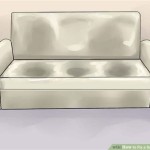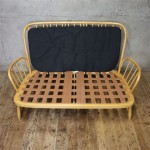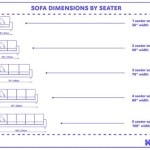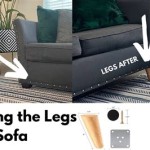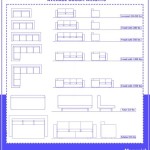Fixing a Sagging Sofa Bed with Plywood: A Practical Guide
Sofa beds offer a versatile solution for optimizing space, providing seating during the day and a sleeping area for guests at night. However, the complex mechanics and frequent use can lead to sagging, particularly in the sleeping platform. This sagging not only compromises comfort but can also accelerate structural damage to the sofa bed. A cost-effective and relatively straightforward solution for addressing this issue involves reinforcing the base with plywood.
This article outlines a comprehensive guide to fixing a sagging sofa bed using plywood. It details the necessary materials, tools, and step-by-step instructions for a successful repair, extending the lifespan of the furniture and restoring its comfort and functionality. This method is particularly suitable for sofa beds where the primary cause of sagging is a weakening or failure of the underlying support structure rather than worn-out cushions or springs.
Identifying the Problem and Assessing the Damage
Before commencing any repair, a thorough assessment of the sofa bed's condition is crucial. The first step involves visually inspecting the sleeping platform when it is both in the sofa and bed positions. Look for obvious signs of sagging, such as a noticeable dip in the center or uneven surface. Pay close attention to the supporting frame underneath. Check for broken or cracked wooden slats, bent or damaged metal supports, and loose or detached connections.
Next, physically test the sagging area. Apply pressure to different points on the platform to identify the weakest spots and determine the extent of the sagging. Listen for creaking or cracking sounds, which can indicate underlying structural issues. It is particularly important to investigate the hinges and folding mechanisms, as these are common points of failure.
The type of sofa bed construction will also influence the repair approach. Some sofa beds have a simple slat system, while others utilize metal frames with wire mesh or interlocking springs. Understanding the specific construction will help determine the appropriate thickness and type of plywood needed for reinforcement. If the damage is limited to a few broken slats, replacing only those slats might suffice. However, if the sagging is widespread, a more comprehensive plywood reinforcement will be necessary.
Finally, consider the overall condition of the sofa bed. If the upholstery is severely worn or the frame is extensively damaged beyond repair, investing in a new sofa bed might be a more practical long-term solution. This method is best suited for situations where the primary issue is a reasonably localized and structurally repairable problem.
Materials and Tools Required for the Repair
Successful implementation of this fix hinges on acquiring the right materials and tools. The key material is the plywood, the selection of which must be carefully considered. The thickness of the plywood will depend on the severity of the sagging and the overall weight it needs to support. As a general guideline, ½ inch to ¾ inch plywood is often sufficient for most sofa beds. Opt for a grade of plywood that is smooth and free of knots or voids, such as sanded plywood or cabinet-grade plywood, to ensure a consistent and durable surface.
Besides plywood, other essential materials include wood screws, wood glue, and measuring tape. The wood screws should be long enough to securely attach the plywood to the existing frame but not so long that they protrude through the other side. Wood glue will provide additional bonding strength between the plywood and the frame. Measuring tape is necessary for accurately determining the dimensions of the plywood and ensuring a proper fit.
The necessary tools comprise a circular saw or jigsaw for cutting the plywood to size, a drill with various drill bits for creating pilot holes and driving screws, a screwdriver (either manual or powered), a sanding block or sandpaper for smoothing rough edges, a pencil for marking measurements, and safety glasses to protect the eyes during cutting and drilling. A square or level is also useful for ensuring accurate measurements and alignment.
Optional but recommended items include clamps for holding the plywood in place while the glue dries, a stud finder to locate framing members for secure attachment, and a dust mask to prevent inhalation of sawdust. Having all the necessary materials and tools readily available will streamline the repair process and increase the likelihood of a successful outcome.
Step-by-Step Instructions for Plywood Reinforcement
Once the problem has been diagnosed and the necessary materials and tools assembled, the repair process can begin. The first step is to measure the interior dimensions of the sofa bed frame where the plywood will be installed. Accurately measure the width and length of the area to be covered, taking into account any obstructions or irregularities in the frame. It is advisable to create a template out of cardboard or paper to ensure a precise fit before cutting the plywood.
Next, use the circular saw or jigsaw to cut the plywood to the measured dimensions. Exercise caution when using power tools and always wear safety glasses. Cut along the marked lines carefully to ensure straight and accurate cuts. After cutting, sand the edges of the plywood with a sanding block or sandpaper to remove any splinters or rough spots. This will prevent the plywood from snagging on the upholstery or causing discomfort.
Apply a generous amount of wood glue to the top surface of the existing sofa bed frame where the plywood will be attached. Position the cut plywood panel onto the frame, ensuring it is centered and aligned correctly. Clamp the plywood in place to hold it securely against the frame while the glue dries. Allow the glue to dry completely according to the manufacturer's instructions, typically for at least 24 hours.
After the glue has dried, reinforce the attachment by driving wood screws through the plywood and into the frame. Pre-drill pilot holes before driving the screws to prevent the wood from splitting. Space the screws evenly around the perimeter of the plywood and along any internal framing members. Ensure the screws are driven deep enough to be flush with the surface of the plywood. If desired, counter-sink the screws slightly and fill the holes with wood filler for a smoother finish.
Inspect the finished repair to ensure the plywood is securely attached and provides adequate support. Test the sofa bed in both the sofa and bed positions to verify that the sagging has been eliminated and the sleeping platform is stable and level. If necessary, add additional plywood panels or screws to further reinforce any weak areas. With proper installation and attention to detail, this plywood reinforcement will significantly improve the comfort and longevity of the sofa bed.
For sofa beds with more complex mechanisms, such as those with folding metal frames, the approach may need to be adjusted. In these cases, focus on reinforcing the areas where the metal frame attaches to the wooden frame or where the metal frame itself is bending. Plywood can be cut and shaped to fit within the metal frame, providing additional support and preventing further bending or breakage. When working with metal frames, use self-tapping metal screws to securely attach the plywood.
It's also important to consider the upholstery when making these repairs. If the upholstery is loose or damaged, it may need to be reattached or replaced. This can be done by carefully removing the existing staples or tacks, stretching the fabric taut over the repaired frame, and reattaching it with new staples or tacks. If the upholstery is significantly damaged, it may be worth considering professional reupholstering to restore the sofa bed to its original condition.
Regular maintenance can help prevent future sagging and extend the lifespan of the sofa bed. Avoid placing excessive weight on the sleeping platform, especially in the center. Rotate the cushions regularly to distribute wear evenly. Inspect the frame periodically for any signs of damage or looseness and address any issues promptly. By taking these preventative measures, the sofa bed can provide years of comfortable seating and sleeping.

How To Fix A Sagging Couch With Plywood Or Particleboard Dengarden

Plywood Mid Century Modern Daybed Diy Deeply Southern Home

Loft Living Simple Sofa With End Tables

3 Ways To Fix A Sagging Couch Or Sofa Simple And Easy Diy Springs Foam Supports

40 Folding Flat Pack Plywood Sofa Diy Curious Creator

How To Re Cushions And Fix A Sagging Couch Comfort Works Blog Sofa Resources

Multifunctional Diy Sofa Bed

How To Fix A Sagging Couch With Plywood Or Particleboard Cushions Repair

4 Ways To Fix Sagging Sofa Cushions Wikihow

50 Easy Ways To Build A Diy Couch Without Breaking The Bank

